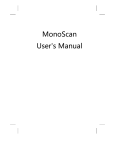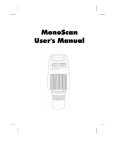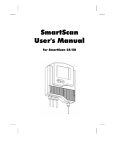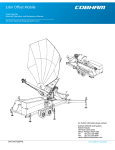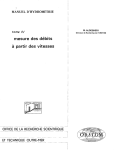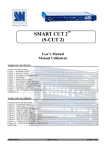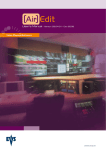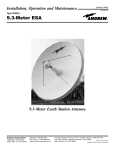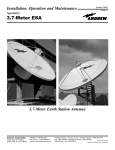Download DWYER INSTRUMENTS, INC. Phone: 219/879-8000
Transcript
L-UL:SSS-1000 12/15/10 8:56 AM Page 1 Bulletin L-UL Series UL Transmitters Specifications - Installation and Operating Instructions DWYER INSTRUMENTS, INC. P.O. BOX 373 • MICHIGAN CITY, INDIANA 46361, U.S.A. Phone: 219/879-8000 Fax: 219/872-9057 www.dwyer-inst.com e-mail: [email protected] L-UL:SSS-1000 12/15/10 8:56 AM Page 2 Table of Contents Table of Figures Chapter 1. Introduction Specifications . . . . . . . . . . . . . . . . . . . . . . . . . . . . . . . . . . . . . . . . . . . . . . . . . . . . .2 Measuring Ranges . . . . . . . . . . . . . . . . . . . . . . . . . . . . . . . . . . . . . . . . . . . . . . . .2 Figure Figure Figure Figure Figure Figure Figure Figure Figure Figure Figure Figure Figure Figure Figure Figure Figure Chapter 2. Installation Precautions . . . . . . . . . . . . . . . . . . . . . . . . . . . . . . . . . . . . . . . . . . . . . . . . . . . . . .3 Installing the Unit on Threaded Flange/Thread-Free Flange . . . . . . . . . . . . . . . .3 Installing the Unit via Extension Pipes . . . . . . . . . . . . . . . . . . . . . . . . . . . . . . . . .4 Using a Conduit Adapter . . . . . . . . . . . . . . . . . . . . . . . . . . . . . . . . . . . . . . . . . . . .4 Non-Intrinsically Safe Connections . . . . . . . . . . . . . . . . . . . . . . . . . . . . . . . . . . . .4 Power Supply and Load Resistance Recommendations . . . . . . . . . . . . . . . . . . .4 Chapter 3. Set Up Series UL Functions . . . . . . . . . . . . . . . . . . . . . . . . . . . . . . . . . . . . . . . . . . . . . . .5 Set Up and Function Access . . . . . . . . . . . . . . . . . . . . . . . . . . . . . . . . . . . . . . . . .5 Resetting the Unit . . . . . . . . . . . . . . . . . . . . . . . . . . . . . . . . . . . . . . . . . . . . . . . . .6 Entering Distance to Empty Level (Tank Height) . . . . . . . . . . . . . . . . . . . . . . . . . .6 Defining Interfering Signals . . . . . . . . . . . . . . . . . . . . . . . . . . . . . . . . . . . . . . . . . .6 Configuring 4 mA Current Output . . . . . . . . . . . . . . . . . . . . . . . . . . . . . . . . . . . . .7 Configuring 20 mA Current Output . . . . . . . . . . . . . . . . . . . . . . . . . . . . . . . . . . . .7 Selecting Low/High Dynamic Speed . . . . . . . . . . . . . . . . . . . . . . . . . . . . . . . . . .8 Defining Working Area . . . . . . . . . . . . . . . . . . . . . . . . . . . . . . . . . . . . . . . . . . . . . .8 Selecting Distance or Level Display . . . . . . . . . . . . . . . . . . . . . . . . . . . . . . . . . . .8 Entering Factor for Gas Compensation . . . . . . . . . . . . . . . . . . . . . . . . . . . . . . . . .9 Restoring the Default Settings . . . . . . . . . . . . . . . . . . . . . . . . . . . . . . . . . . . . . . . .9 Shifting the Blocking Distance . . . . . . . . . . . . . . . . . . . . . . . . . . . . . . . . . . . . . . . .9 Verifying the Version Number . . . . . . . . . . . . . . . . . . . . . . . . . . . . . . . . . . . . . . . .9 Defining 22 mA Signal Error Messages . . . . . . . . . . . . . . . . . . . . . . . . . . . . . . .10 Chapter 4. Open Channels (ULF) Selecting the Flow Measurement Settings . . . . . . . . . . . . . . . . . . . . . . . . . . . . .10 Open Channel Flow Measurements . . . . . . . . . . . . . . . . . . . . . . . . . . . . . . . . . .10 Flume/Weir Types . . . . . . . . . . . . . . . . . . . . . . . . . . . . . . . . . . . . . . . . . . . . . . . .11 Flumes/Weirs - European Standard . . . . . . . . . . . . . . . . . . . . . . . . . . . . . . . . . .11 Rectangular Suppressed Sharp - Crested Weir (Type 1) . . . . . . . . . . . . . . . . . .11 Rectangular Contracted Sharp - Crested Weir (Type 2) . . . . . . . . . . . . . . . . . . .11 Trapezoidal (Cipolletti) Sharp - Crested Weir (Type 3) . . . . . . . . . . . . . . . . . . . .11 V-Notch (Triangular) Sharp - Crested Weir (Type 4) . . . . . . . . . . . . . . . . . . . . . .11 Khafagi-Venturi Flume (Type 5) . . . . . . . . . . . . . . . . . . . . . . . . . . . . . . . . . . . . . .12 Parshall Flume (Type 6) . . . . . . . . . . . . . . . . . . . . . . . . . . . . . . . . . . . . . . . . . . .12 Palmer Bowlus Flume Trapezoidal Throat Cross-Selection (Type 7) . . . . . . . . .12 H Flume (Type 8) . . . . . . . . . . . . . . . . . . . . . . . . . . . . . . . . . . . . . . . . . . . . . . . . .12 Neyrpic Venturi Flume/Long-Base Weir (Type 9) . . . . . . . . . . . . . . . . . . . . . . . .13 Flumes/Weirs – American Standard . . . . . . . . . . . . . . . . . . . . . . . . . . . . . . . . . .13 Rectangular Suppressed Sharp - Crested Weir (Type 1) . . . . . . . . . . . . . . . . . .13 Rectangular Contracted Sharp - Crested Weir (Type 2) . . . . . . . . . . . . . . . . . .13 Trapezoidal (Cipolletti) Sharp - Crested Weir (Type 3) . . . . . . . . . . . . . . . . . . . .13 V-Notch (Triangular) Sharp - Crested Weir (Type 4) . . . . . . . . . . . . . . . . . . . . . .13 Parshall Flume (Type 5) . . . . . . . . . . . . . . . . . . . . . . . . . . . . . . . . . . . . . . . . . . .14 Palmer Bowlus Flume Trapezoidal Throat Cross-Selection (Type 6) . . . . . . . . .14 H Flume (Type 7) . . . . . . . . . . . . . . . . . . . . . . . . . . . . . . . . . . . . . . . . . . . . . . . . .14 Leopold-Lagco Flume (Type 8) . . . . . . . . . . . . . . . . . . . . . . . . . . . . . . . . . . . . . .14 Figure Figure Figure Figure Figure Figure Figure Figure Figure Figure Figure Figure Chapter 5. Troubleshooting 22 mA Signal Error Messages . . . . . . . . . . . . . . . . . . . . . . . . . . . . . . . . . . . . . . .15 Appendix A – Gas Factor Table . . . . . . . . . . . . . . . . . . . . . . . . . . . . . . . . . . . . . .16 Appendix B – Installation Tips . . . . . . . . . . . . . . . . . . . . . . . . . . . . . . . . . . . . . . .16 Appendix C – Nomenclature . . . . . . . . . . . . . . . . . . . . . . . . . . . . . . . . . . . . . . . .17 Page 1 1: Front and Side View . . . . . . . . . . . . . . . . . . . . . . . . . . . . . . . . . . . . . . . . . .2 2: Threaded Flange/ Thread - Free Flange Monitoring . . . . . . . . . . . . . . . . .3 3: Extension Pipe Recommendation . . . . . . . . . . . . . . . . . . . . . . . . . . . . . . .4 4: Conduit Adapter . . . . . . . . . . . . . . . . . . . . . . . . . . . . . . . . . . . . . . . . . . . . .4 5: Non-Intrinsically Safe Positive Ground Connection . . . . . . . . . . . . . . . . . .4 6: Non-Intrinsically Safe Negative Ground Connection . . . . . . . . . . . . . . . . .4 7: Functions Menus . . . . . . . . . . . . . . . . . . . . . . . . . . . . . . . . . . . . . . . . . . . . .5 8: Display and Function Buttons . . . . . . . . . . . . . . . . . . . . . . . . . . . . . . . . . . .5 9: Scan Distance Process . . . . . . . . . . . . . . . . . . . . . . . . . . . . . . . . . . . . . . . .6 10: Defining Working Area . . . . . . . . . . . . . . . . . . . . . . . . . . . . . . . . . . . . . . .8 11: Rectangular Suppressed Sharp - Crested Weir . . . . . . . . . . . . . . . . . . .11 12: Rectangular Contracted Sharp - Crested Weir . . . . . . . . . . . . . . . . . . . .11 13: Trapezoidal (Cipolletti) Sharp - Crested Weir . . . . . . . . . . . . . . . . . . . . .11 14: V-Notch (Triangular) Sharp - Crested Weir . . . . . . . . . . . . . . . . . . . . . . .11 15: Khafagi-Venturi Flume . . . . . . . . . . . . . . . . . . . . . . . . . . . . . . . . . . . . . .12 16: Parshall Flume . . . . . . . . . . . . . . . . . . . . . . . . . . . . . . . . . . . . . . . . . . . .12 17: Palmer Bowlus Flume Trapezoidal Throat Cross-Selection . . . . . . . . . . . . . . . . . . . . . . . . . . . . . . . . . . . . . . . . . . .12 18: H Flume . . . . . . . . . . . . . . . . . . . . . . . . . . . . . . . . . . . . . . . . . . . . . . . . .12 19: Neyrpic Venture Flume . . . . . . . . . . . . . . . . . . . . . . . . . . . . . . . . . . . . . .13 20: Long-Base Weir . . . . . . . . . . . . . . . . . . . . . . . . . . . . . . . . . . . . . . . . . . .13 21: Rectangular Suppresses Sharp - Crested Weir . . . . . . . . . . . . . . . . . . .13 22: Rectangular Contracted Sharp - Crested Weir . . . . . . . . . . . . . . . . . . .13 23: Trapeziodal (Cipolletti) Sharp - Crusted Weir . . . . . . . . . . . . . . . . . . . . .13 24: V-Notch (Triangular) Sharp - Crested Weir . . . . . . . . . . . . . . . . . . . . . . .13 25: Parshall Flume . . . . . . . . . . . . . . . . . . . . . . . . . . . . . . . . . . . . . . . . . . . .14 26: Palmer Boweus Flume Trapezoidal Throat Cross-Selection . . . . . . . . . . . . . . . . . . . . . . . . . . . . . . . . . . . . . . . . . . .14 27: H Flume . . . . . . . . . . . . . . . . . . . . . . . . . . . . . . . . . . . . . . . . . . . . . . . . .14 28: Leopold Lagco Flume . . . . . . . . . . . . . . . . . . . . . . . . . . . . . . . . . . . . . . .14 29: Nomenclature . . . . . . . . . . . . . . . . . . . . . . . . . . . . . . . . . . . . . . . . . . . . .17 L-UL:SSS-1000 12/15/10 8:56 AM Page 3 SPECIFICATIONS Service: ULB: Bulk solids, ULF: Compatible liquids. Wetted Materials: Sensor: Polypropylene, Acoustic Window: ECTFE. Ranges: (see “Measuring Ranges”). Accuracy: 0.25% of max range (at 20°C). Resolution: 0.04˝ (1 mm). Blind Zone: ULB-11 and ULF-X1-XXX: 0.8 ft (.25 m); ULB-12 and ULB-X2-XXX: 1.96 ft (0.6 m). Beam Angle: 5° @ 3db point. Temperature Limits: -40 to 158°F (-40 to 70°C). Temperature Compensation: Automatic. Pressure Limits: 13.5 psi (0.9 bar) to 30 psi (2 bar). Power Requirement: 18 to 28 VDC. Output Signal: 4 to 20 mA. Max. Loop Resistance: 750 Ω at 28 VDC. Electrical Connection: Screw terminal. Conduit Connection: 1/2˝ NPT conduit or cable gland (optional). Process Connection: 2˝ NPT or 2˝ BSP (optional). Enclosure: Plastic enclosure: ABS and UV resistant body. Enclosure Rating: NEMA 4 (IP65). Mounting Orientation: Vertical. Memory: Non-volatile. Display: 4 character LCD. Units: ft, m (upon request). Programming: 4 button. Weight: 3.1 lb (1.4 kg). Chapter 1: Introduction The UL is an ultrasonic, continuous-level measurement gage. The unit is available in two separate series: The Series ULB for solids and the Series ULF for fluids. Depending on the series, the unit can be used for the following measurement tasks: • Dust-free tanks with solids • Open channel flow • Liquid tanks with calm surfaces (upon request) The ULF unit has a range of up to 49.21 ft (15 m) with an accuracy of 0.25% of the maximum measuring range (version dependent). The ULB unit has a range of up to 28 ft (8.5 m) with an accuracy of 0.25% of the maximum measuring range (version dependent). Measuring Ranges Standard 0.82 ft to 11.5 ft 0.25 m to 3.5 m Extended Range 1.96 ft to 28 ft 0.6 m to 8.5 m Short Range 0.82 ft to 16.4 ft 0.25 m to 5 m Standard 1.96 ft to 49.2 ft 0.6 m to 15 m ULB for solids Figure 1 : Front and Side View ULF for fluids Page 2 L-UL:SSS-1000 12/15/10 8:56 AM Page 4 Installing the Unit on Threaded Flange/Thread-Free Flange The unit is available in 2˝ NPT or 2˝ BSP (upon request). Chapter 2: Installing the Unit Precautions • Ensure that the unit is mounted in an area that meets the stated temperature, pressure and technical specifications. • Ensure that high-voltage sources or cables are at least 40˝ (1 m) away from the sensor and its cable. • Use round cables with minimum diameter of 0.24 to 0.28˝ (6 to 7 mm) to ensure that the unit remains sealed per IP65 standards. • Ensure that cables are routed correctly and tightened along walls or pipes. • Installation and operation of this product should be performed, according to the Product User Manual and Product Certification. Otherwise the use of this product is prohibited. The unit can be installed with threaded-flange mounting or with thread-free flange mounting, as shown below: When installing the unit ensure that it is: • Mounted above the dead-zone area. NOTE: If the device enters the blocking distance (dead zone), it will not measure correctly. Figure 2: Threaded Flange/Thread-Free Flange Mounting NOTE: When installing a thread-free flange mounted unit, you will need a 2˝ (50.8 mm) locking nut to secure the unit inside the tank. • Positioned at least 1.64 ft (0.5 m) away from the tank walls. Add 4˝ (10 cm) spacing for each 40˝ (1 m) in range. To Install the Unit: 1. Insert the threaded end of the unit into the opening at the top of the tank or pipe. 2. Bolt the unit into place in one of the following ways: • Threaded-flange mounting: Screw the unit into a flange with a threaded 2˝ (50.8 mm) hole. • Thread-free mounting: Place the unit in the flange, and bolt it from within the tank with a 2˝ (50.8 mm) locking nut. NOTE: Tighten nut hand tight only. When tightening the nut, hold the lower part of the unit. Make sure that the seal is leak proof. • Perpendicular to the surface of the target. NOTE: Even the slightest difference in angle may affect echo quality. • Placed as far as possible from noisy areas, such as a filling inlet. NOTE: When installed in a humid environment it is recommended to position the sensor on a tripod on top of the vessel. Page 3 L-UL:SSS-1000 12/15/10 8:56 AM Page 5 Non-Intrinsically Safe Connections Installing the Unit Via Extension Pipes If the level of the measured surface falls within the dead-zone area, you should use an extension pipe to mount the unit. When using an extension pipe, ensure that: • The sensor is positioned in the center of the pipe. • The pipe extension is exactly perpendicular to the surface of the target. • The internal pipe diameter is at least 3.0˝ (76.2 mm) wide. • The pipe is preferably made of plastic and must have a smooth interior surface. • The pipe should not protrude inside the tank. • The tank drilling should be at least the size of the internal pipe diameter and have a smooth edge. Figure 5: Non-Intrinsically Safe Positive Ground Connection When installing the unit with extension pipes, measure from sensor’s lower edge and follow these specifications: Pipe Length Internal Pipe Diameter 1.64 ft (0.5 m) ≥ 3.0˝ (76.2 mm) NOTE: 1. It is always recommended to use interference signal feature (Pr03) to locate interfering signals when using an extension pipe. 2. The sensor's lower edge may be a) aligned with the extension pipe's upper edge or b) protrude it by up to 2.56˝ (6.5 cm). See Figure 3 below: Figure 6: Non-Intrinsically Safe Negative Ground Connection Power Supply and Load Resistance Recommendations The following table specifies the recommended resistance range for each power supply voltage (Non-Intrinsically Safe). Power Supply Voltage 15 V 18 V 24 V 28 V a Maximum Minimum Resistance Value Resistance Value 136 Ω 0Ω 272 Ω 0Ω 545 Ω 41 Ω 727 Ω 68 Ω NOTE: The resistance value is the total sum of the series resistor (or PLC resistance) and the lines resistance. The minimum voltage level on terminals should not be less that 15 VDC. b Figure 3: Extension Pipe Recommendation To maintain a proper seal, make sure that conduit is firmly screwed to the conduit's adaptor. Using a Conduit Adapter 1. Remove the four retaining screws from the conduit adapter cover. 2. Pull the electrical wires through the 1/2˝ NPT conduit connection. 3. Connect the -24 V wire to Terminal 1, connect the +24 V wire to Terminal 2 on the wiring block. 4. Return the adapter's cover to its place properly. Make sure that the O-ring is placed correctly. Fasten the four retaining screws. Ripple/Noise Parameters Recommended for the Power Supply The following ripple/noise parameter are recommended for the power supply: • 100 mV p-p max. Power Supply Types Recommendations • Prefer a regulated switching power supply. • A rectified power supply is not recommended. • When powering by a battery, avoid the using of switched charger. Feeding Via PLC • Verify that the voltage level on the unit’s terminals is at least 15 VDC. • Check PLC specifications for grounding options. • It is good practice to add a 150 Ω series resistor between the unit's positive terminal and the PLC. Figure 4: Conduit Adapter NOTE: The conduit adapter should not exceed a torque of 50 lb-in. To maintain a proper seal, make sure that conduit is firmly screwed to the conduit's adaptor. Page 4 L-UL:SSS-1000 12/15/10 8:58 AM Page 6 Using Series UL Functions The LCD display screen, functioning in "normal" mode, provides continuously updated measurement readings. The display screen is also used to view the menu options, function settings and data values, accessed by using the function buttons. Chapter 3: Setting Up and Calibrating the Unit This chapter explains how to set up and calibrate the unit for accurate measurement monitoring. The unit is supplied with preprogrammed default settings, making it ready for immediate operation. There is no need to change the default settings, unless you wish to calibrate the unit for your specific requirements; however, it is recommended that you replace the default tank height value with the actual tank height, as described on page 6. When using the unit, the tank height is calculated as the distance from the surface of the sensor to the bottom of the tank. You should enter this value whenever tank height is required. (For flow measurement, enter the precise flume height.) The picture below shows the upper part of the unit. The ULF unit contains eleven programs and the ULB unit contains nine programs. These programs are referred to as functions, which enable you to change the default settings and calibrate as required. These functions are accessed from a functions menu. The functions Pr01, Pr02, Pr04 and Pr05 are the most important to ensure correct usage of your device (with the addition of Pr00 if using the appropriate ULF series). Function Pr03 may be used if there are interfering signals. The remaining functions (Pr06, Pr07, Pr08, Pr09 and Pr10) enable you to customize the unit for your monitoring requirements or to restore factory default settings. The diagram below shows the functions available in the functions menus for the Series ULF and Series ULB. Some functions are only relevant for particular series. Figure 8: Display and Function Buttons The function buttons are used to perform various operations, summarized in the following table. Button or Uses Include: • Accessing the functions menu (when pressed simultaneously with ) • Selecting functions • Progressing to the next step of a function • Moving from left to right between displayed digits • Saving changes to data • Accessing the functions menu (when pressed simultaneously with ) • Exiting the functions menu to restore the distance reading • Moving from right to left between displayed digits • Exiting a function without saving changes • Clearing error messages • Scrolling through the functions menu • Scrolling through available data values in functions • NEXT button only: Recording interfering signals NOTE: Within some functions, the digits in the displayed value can be individually modified. This is indicated by a flashing digit (flashing digits are shown in gray in the display illustrations. In this case, the ENT and ESC buttons enable you to move between the digits. Each flashing digit can be modified using the BACK and NEXT buttons. Figure 7: Function Menus Start Up and Function Access: Press/Action Display: Connect unit to power supply Setting flow measurement parameters (function Pr00) for the Series ULF (Open Channels) is described in Chapter 4, Open Channels (ULF). Setting parameters for all other functions and accessing the functions are described in this chapter. After a brief pause and (simultaneously) Explanation Temporary display while unit takes a reading. For example: Distance reading. For example: Enters the functions menu. Used to search for the required menu selection. or Accesses the selected function. Page 5 L-UL:SSS-1000 12/15/10 9:01 AM Page 7 NOTE: If an error message appears, press the ESC button to return to the main menu. Values are displayed in feet and inches or meters and centimeters (model dependent). Defining Interfering Signals The Pr03 function enables you to locate and store up to six interfering signals (false echoes) in the unit’s memory to avoid having obstructions, such as a tank agitator or a sidewall, interfering with the measurement of the contents. Defining interfering signals is done while the tank is empty. Resetting the Unit The PR01 function enables you to do a reset by refreshing the measurement reading. (Other saved function settings are not changed.) After resetting, the actual reading is displayed on the LCD, and the unit begins to scan (same as in turning the unit on/off). The reset function may sometimes be required after changing one of the settings or after receiving an error message. NOTE: During reset the unit will display 8.8.8.8 followed by 22 mA current output. To Reset The Unit: Press/Action Display Explanation Required menu selection. and (simultaneously) Figure 9: Scan Distance Process Temporary display while unit takes a reading. For example: Each reading (scan distance) taken using the Pr03 function is stored as an interfering signal, until a reading is achieved that indicates the real echo. If six interfering signals are already stored, the next read values will not be saved. Distance reading. After a brief pause NOTE: The reading of the actual target height may not be exact, for example, a target height of 19.69 ft (6 m) may give a reading in the range 19.62 to 19.75 ft (5.98 to 6.02 m). Returns to the functions menu. and (simultaneously) The displayed values are in distance units. To Define Interfering Signals: Press/Action Display Entering Distance to Empty Level Use Pr02 function to enter the distance from sensor face to empty level of the tank. When sensor face coincides with tank top, enter the height of the tank. Default value is the maximum range for your model. If you enter a value that exceeds this highest value, an Err error message is displayed and the value is not saved. Select Search to locate acoustic interferences, or Clear to delete stored interferences. NOTE: For flow measurements, enter the precise distance from the sensor to the bottom of the flume. or Displayed after the selection for 3 seconds and then the menu returns to Pr03. Temporary display while the unit searches for interfering signals. Modified to read between 0 and 5 (feet) U.S. Standard Units or between 0 and 1 (meters) metric units (model dependent). To Enter Tank Height Value: Press/Action Display Explanation Required menu selection. After a brief pause For example: Indicates the measurement unit in feet or meters (upon request). For example: Explanation Required menu selection. Displays last saved tank height or default value (maximum value in range). For example: Used to enter a new value. Depth to interfering signal. Saves the interfering signal, then searches again and displays the next reading. Continue to press this button to save up to six interference readings. Actual target height reading indicates that there are no more interfering signals. Saves the entered values. or NOTE: If the value represents an interference, false echo or false target: press NEXT. If the value represents the real target, real distance: press ENT. or OR To save the new value, press when standing on the far right digit. After YES is displayed, the display returns to the functions menu. To return to the main menu without saving, press when standing on the far left digit. Page 6 L-UL:SSS-1000 12/15/10 9:03 AM Page 8 Configuring 20 mA Current Output The Pr05 function enables you to enter values to be used as the 20 mA mark for remote monitoring. Configuring 4 mA Current Output Pr04 function enables you to enter values to be used as the 4 mA mark for remote monitoring. You can define the 4 mA values for level, distance or flow measurements (depending on series). The measurement value types should be defined in Pr04. These definitions will be applicable as well for the 20 mA values defined in Pr05. To Enter 20 mA Values: Press/Action To set 4 mA and 20 mA for level measurements you should configure Pr04 and Pr05 for level values. For example, if we measure a tank with tank height configured for 16.4 ft (5.0 m), the 4 mA values will represent zero tank level and 20 mA values will represent full tank level. Therefore, the value entered in Pr04 will be 0.0 ft (0.0 m) and the value entered in Pr05 will be 16.4 ft (5.0 m). When setting 4 mA and 20 mA for distance measurements, 4 mA values will represent the minimal distance between the surface of the target and the sensor and 20 mA values will represent the maximal distance between the sensor and the surface of the target. Therefore, 4 mA represents the full part of the tank and 20 mA represents the empty part of the tank. Press/Action Display Explanation Required menu selection. For example: Select the format for 4 mA and 20 mA values to level (L000), distance (d000) or flow (F000) (depending on model). Display Explanation Required menu selection. For example: Last saved 20 mA level or default value (maximum value in range). Used to enter a new value. or or OR or For example: Last saved 4 mA level or zero default value. To save the new value, press when standing on the far right digit. After YES is displayed, the display returns to the functions menu. To return to the main menu without saving, press when standing on the far left digit. NOTE: The type of measurement (level, distance or flow) selected in Pr04 is also applicable for Pr05. Used to enter a new value. The values for 4 mA and 20 mA must be different; otherwise an Err (error message) is displayed. or The values for 4 mA and 20 mA should not be higher than the value used for the tank height (Pr02). or The first digit of the 20 mA value can be modified to read between 0 and 5 for U.S. Standard Units or between 0 and 1 for metric units (model dependent). To save the new value, press when standing on the far right digit. After YES is displayed, the display returns to the functions menu. To return to the main menu without saving, press when standing on the far left digit. After accessing the Pr05 function, the unit generates a fixed current of 22 mA on the 4 to 20 mA line. When the unit reverts to regular scanning mode, the 4 to 20 mA line returns to regular functioning. Please refer to Chapter 5 Troubleshooting for 20 mA error indications. NOTE: The values for 4 mA and 20 mA must be different, otherwise an Err (error message) is displayed. The values for 4 mA and 20 mA should not be greater than the value used for the tank height (Pr02). Because of the dead-zone, the distance between the sensor and the surface of the target at its highest level should be a minimum of 0.82 ft (0.25 m) for ULB Standard-Range and ULF Short-Range models, or 1.96 ft (0.6 m) for ULB Extended-Range and ULF Standard-Range models. The first digit of the 4 mA value can be modified to read between 0 and 5 (feet) for U.S. Standard Units or between 0 and 1 (meters) metric units (upon request). After accessing the Pr04 function, the unit generates a fixed current of 22 mA on the 4 to 20 mA line. When the unit reverts to regular scanning mode, the 4 to 20 mA line returns to regular functioning. The default values for 4 mA and 20 mA in both the ULB and ULF Liquid Series are level. The default values for 4 mA and 20 mA in ULF Open Channel Series are flow. When changing from one measurement mode to another, the measurement units will be changed automatically (for example, when changing from level mode to flow mode, the units will change from feet to GPM or meters to M3/H (depending on the model). The measurement mode selected for the 4 to 20 mA values will not influence the measurement mode selected for the display (Pr08). In case of power rest, measurement configuration (level, distance, flow) will be saved according to the unit's last configuration. Page 7 L-UL:SSS-1000 12/15/10 9:06 AM Page 9 To Define a Working Area: Selecting Low/High Dynamic Speed (ULF Series Only) The Pr06 function enables you to choose the required speed level. There are two settings available: • SE 0: Low dynamic mode (default setting). This mode provides slower readings with a greater degree of accuracy (rate of up to 31˝/80 cm per min). • Fail Safe: 10 minutes. • SE 1: High dynamic mode. This mode provides faster readings but with less precision (rate of up to 39˝/100 cm per min). • Fail Safe: 3 minutes. Press/Action Display Displayed when entering the function. For example: NOTE: Fail Safe timer determines the waiting period from an echo loss until a transmission of an error signal. To Select the Speed Mode: Press/Action Display Explanation Required menu selection. Displays the value last saved in the tank height (default). The entered value should not be more than double the tank height and should not exceed the unit's maximum measuring range. Used to enter a new value. or Explanation Required menu selection. or Displays the current operation mode setting. Saves the entered value. or Used to move on to the next function. Used to toggle between the operations modes. or or Saves the selected operation mode. Selecting Distance or Level Display (for ULB and ULF Liquid Only) The Pr08 function enables you to choose whether the unit displays either distance or level measurements. There are two settings available: • d000: Distance mode (default setting): In this mode, the unit displays the distance from the sensor to the surface of the contents. • L000: Level mode: In this mode, the unit displays the level of the contents from the bottom of the tank. Defining Working Area The Pr07 function allows you to add distance range that exceeds the tank's height, thus enabling accurate readings of complicated tank shapes with conic ending. This may be required when the vessel has a conical bottom shape, which is causing false echoes and consequently faulty measurements. The minimal value can be the entered tank height and the maximal value can be double the value of the entered tank height. The default setting is the entered tank height. NOTE: The measurement mode selected for the display will not influence the measurement mode selected for the 4 to 20 mA values (Pr04). The ULF Open Channel only displays open channel flow measurement. To Select Distance or Level Display: Press/Action Display Explanation Required menu selection. Displays the current distance/level mode setting. or Used to toggle between the modes. or Saves the selected mode. Figure 10: Defining Working Area NOTE: It is recommended to use the Pr07 function only in distance mode. Page 8 L-UL:SSS-1000 12/15/10 9:08 AM Page 10 Shifting the Blocking Distance This function enables you to define an area in which measurement results would be ignored. This option is applicable for installations requiring extension pipes or nuzzles positioned above the material level. This area should approximately fit the pipe/nuzzle length to eliminate false echoes and to provide accurate and stable measurement readings. Entering Factor for Gas Compensation Function Pr09 enables you to compensate for sound velocity changes in different types of gasses. You can enter the appropriate factor for each type of gas listed on the “Gas Factor Table” (Appendix A). For example, the sound velocity in air (at room temperature) is 1125 ft/sec (343 m/sec) and for Methane (Ch4) 1463 ft/sec (445.82 m/sec). Therefore, a factor of 1463/1125 = 1.30 should be entered to compensate for this type of gas. This factor will compensate in cases when the gas compound consists of 100% Methane. In case the gas is not pure, the sound velocity cannot be estimated and therefore a minor deviation could appear. It is recommended to use a reference measurement indicator (using a tape or other measuring device) and compare the measurement results between the unit and the reference measurement indicator. If the result is correct, press ENT. If the accuracy deviation is higher than expected, continue and calibrate the factor to meet the gas maintained in the vessel. For example, if the gas composition consists of water and gas you can add ± 0.01 to the factor figure already entered, to meet your application requirements. The “Gas Factor Table” supports up to 32 different types of gasses. For any other type of gas, not included in this table, please contact Dwyer Customer Support, (www.dwyer-inst.com). Press/Action Display • To Shift the Blocking Distance: Follow the directions given for Entering Distance to Empty Level (Tank Height), page 6. Instead of entering the tank height value, enter 00.01, and continue as follows: Press/Action Display Explanation Insert this code to enter the blocking distance area. This message will flash for a few seconds, indicating an entry to the blocking distance area. For example: or Explanation Required menu selection. Shifts the blocking distance to 2.46 ft (0.75 m). or Default screen. Saves this entry and returns to Pr02. Default value. NOTE: Shifting of the blocking distance is limited to 4.9 ft (1.5 m). The value entered to the SBD incorporates the Dead Zone Value. Choose a factor from the “Gas Factor Table” (Appendix A). Pr10 (Clear) reverts the blocking distance to its default. or Echo received from the defined blocking distance area will be ignored by the unit and the measurement result will be based on the next echo. or For example: When installing via extension pipe, it is recommended to keep approx. 2˝ (5 cm) gap between the shortest distance to target (maximal level) and the lower pipe edge. Set the SBD length to a value that is 2˝ (5 cm) smaller than the distance from the sensor's lower edge to pipe's lower edge, in order to avoid second harmony interference. This is the factor for Ethanol. Saves the chosen gas factor. NOTE: Repeat this procedure if the measurement results differ from the actual material level measured with a reference tape (or other reference measurement method). Add or reduce 0.01 to calibrate the factor figure already entered. Updated on-screen results may take a few seconds to appear. Verifying the Version Number In addition to the functions described, you can verify the UL series version number. • To Verify the Version Number: Follow the directions given for Entering Distance to Empty Level (Tank Height), page 6. Instead of entering the tank height value, enter 00.17, and continue as follows: Press/Action Display Explanation Restoring the Default Settings The Pr10 function allows clearing all user-defined settings and reverting to the default factory settings. Default factory settings are: Pr00: GPM 1U01 or M³/Hr 1E01 Pr02: Sbd 00.00, E000, Tank Height =default Pr03: Resets all interfering signals Pr04: Solid/Liquid device L000, 00.00 or Flow device F000, 00.00 Pr05: Solid/Liquid device Tank Height = Pr.02 Flow device 55500 M³/Hr or 244400 GPM Pr06: SE 0 (Liquid and Flow) Pr07: Tank Height = Pr.02 Pr08: Solid/Liquid device d000 Pr09: 01.00 After a brief pause Displays the version number. NOTE: If you decide not to revert to the default settings, press ESC when CLCL is displayed. A redo option is not available when ENT has been pressed. To Restore the Default Settings: Press/Action Display Explanation Required menu selection. Reverts all settings to default factory settings. Page 9 L-UL:SSS-1000 12/15/10 9:10 AM Page 11 Defining 22 mA Signal Error Messages The unit allows you to define if the following signal error indications: Near Zone and Lost Echo, will be active when the current output reaches 22 mA. The default setting enables 22 mA analog current and error messages to appear on its LCD display. Chapter 4: Open Channels (ULF) This section describes how to set flow measurement parameters for open channels and explains the flume/weir codes methodology used when setting up flow measurements. Near Zone - Whenever the distance is below the defined Dead Zone (depending on the series you are using) message will be displayed on the LCD. Selecting the Flow Measurement Settings The Pr00 function enables you to select one of the preset flumes/weirs settings for flow measurements. This function is available only in the ULF Open Channel series. When setting flow measurement parameters in the Pr00 function, the flume/weir type value (X) is entered first, followed by the letter (U) or (E) that represents either American (USA) or European standard flume/weir. The code value (YY) represents the appropriate flume/weir dimensions in the following format: . The open channel types and codes are described in Open Channels Flow Measurement. Lost Echo - Whenever the echo is lost, or in cases when the measurement results exceed the tank height or when a returned echo is not received message will be displayed on the LCD. You can choose to enable or disable these error messages and 22 mA analog signal as follows: • d000: Disable • E000: Enable (default setting) NOTE: Refer to Chapter 3, Setting Up and Calibrating the Unit, for an explanation of accessing and using the functions menu. Refer to Chapter 5, Troubleshooting for a detailed list of the 22 mA signal error messages. All flow measurement values are displayed divided by 1000. • To Select the Flow Measurement Settings: • To Disable/Enable 22 mA Signal Error in the Unit: Follow the directions given for Entering Distance to Empty Level (Tank Height), page 6. Instead of entering the tank height value, enter 00.16, and continue as follows: Press/Action Display Press/Action Explanation Choose disable. Display Explanation Required menu selection. For example: Indicates the measurement unit for flow 3 in GPM (American standard) or M /h (metric standard) (upon request). Displays last saved flow measurement setting or default value, with first digit flashing U – American standard or E – European standard (upon request). Used to toggle between the modes. or Disables the 22 mA error messages. Use to select a new type value (X). NOTE: When the error signals are disabled the following current outputs will be displayed: (Level or flow measurement): F.F.F.F will indicate 20 mA and E.E.E.E will indicate 4 mA. (Distance measurement): F.F.F.F will indicate 4 mA and E.E.E.E will indicate 20 mA. or Last two digits of the display flash. Use to select a new flume/weir length code (YY). or Selected values are saved. Open Channels Flow Measurements The flume/weir type code methodology used when setting up open channels is based on three digits: X(U/E)YY Where: X refers to the particular flume/weir type U/E refers to either American or European standard flumes/weirs YY refers to the specific flume/weir dimensions The types of flumes/weirs are available in American standard or European standard (upon request). When working in American standard the default flow measurement units will be GPM, and in European standard the default flow measurement units will be M³/Hr. Page 10 L-UL:SSS-1000 12/15/10 9:10 AM Page 12 Flume/Weir Types This is the first value (X) entered for the Pr00 function. The following flume/weir types are available both in European and American standard: European Standard Type (X) Pages 11-13 Rectangular Suppressed 1 Sharp-Crested Weir, Page 11 Rectangular Contracted Sharp2 Crested Weir, Page 11 Trapezoidal (Cipolletti) Sharp3 Crested Weir, Page 11 V-notch (Triangular) Sharp4 Crested Weir, Page 11 Khafagi-Venturi Flume, Page 12 5 Parshall Flume, Page 12 6 7 8 9 Palmer Bowlus Flume Trapezoidal Throat CrossSelection, Page 12 H Flume, Page 12 American Standard Pages 13-14 Rectangular Suppressed SharpCrested Weir, Page 13 Rectangular Contracted SharpCrested Weir, Page 13 Trapezoidal (Cipolletti) SharpCrested Weir, Page 13 V-notch (Triangular) Sharp-Crested Weir, Page 13 Parshall Flume, Page 14 Palmer Bowlus Flume Trapezoidal Throat Cross-Selection, Page 14 H Flume, Page 14 Leopold-Lagco Flume, Page 14 Neyrpic Venturi Flume/LongBase Weir, Page 13 Flumes/Weirs - European Standard Rectangular Suppressed Sharp-Crested Weir (Type 1) Trapezoidal (Cipolletti) Sharp-Crested Weir (Type 3) Code (YY) Crest Length (cm) 01 20 02 40 03 60 04 80 05 100 06 150 07 200 08 300 Code (YY) Crest Length (cm) 01 30 02 45 03 60 04 80 05 100 06 150 07 200 08 300 Figure 11: Rectangular Suppressed Sharp-Crested Weir Figure 13: Trapezoidal (Cipolletti) Sharp-Crested Weir Rectangular Contracted Sharp-Crested Weir (Type 2 ) V-Notch (Triangular) Sharp-Crested Weir (Type 4) Code (YY) Crest Length (cm) 01 20 02 30 03 40 04 50 05 60 06 80 07 100 08 150 09 200 10 300 Code (YY) V-Notch Angle (°) 01 90 02 60 03 53.8 04 45 05 30 06 28.4 07 22.5 British Standard 08 90 09 45 10 22.5 Figure 12: Rectangular Contracted Sharp-Crested Weir Figure 14: V-Notch (Triangular) Sharp-Crested Weir Page 11 L-UL:SSS-1000 12/15/10 9:10 AM Page 13 Khafagi-Venturi Flume (Type 5) Palmer Bowlus Flume Trapezoidal Throat Cross-Selection (Type 7) Code (YY) Conduit Diameter (in) D 01 6 02 8 03 10 04 12 05 15 06 18 07 21 08 24 09 27 10 30 Code (YY) Flume Type b0 (cm) 01 12 QV 302 02 30 QV 303 03 40 QV 304 04 50 QV 305 05 60 QV 306 06 80 QV 308 07 100 QV 310 08 130 QV 313 09 160 QV 316 Figure 15: Khafagi-Venturi Flume Figure 17: Palmer Bowlus Flume Trapezoidal Throat Cross-Selection Parshall Flume (Type 6) H Flume (Type 8) Code (YY) Throat Width (in) 01 1 02 2 03 3 04 6 05 9 06 12 07 18 08 24 09 36 10 48 11 60 12 72 13 96 14 120 15 144 Code (YY) Flume Size (ft) Measurement Point (cm) 01 0.5 5 02 0.75 7 03 1 9 04 1.5 14 05 2 18 06 2.5 23 07 3 28 08 4.5 41 Figure 18: H Flume Figure 16: Parshall Flume Page 12 L-UL:SSS-1000 12/15/10 9:10 AM Page 14 Rectangular Contracted Sharp-Crested Weir (Type 2) Neyrpic Venturi Flume/Long-Base Weir (Type 9) Code (YY) Venturi Flume Type 01 1253AX 02 1253AY 03 1253AZ 04 1253A 05 1253B 06 1253C 07 1253D 08 1253E 09 1253F Code (YY) Crest Length (in) 01 12.00 02 18.00 03 24.00 04 30.00 05 36.00 06 48.00 07 60.00 08 72.00 09 96.00 Figure 19: Neyrpic Venturi Flume Code (YY) Long Base Weir Type 10 1245A 11 1245B 12 1245C 13 1245D Figure 22: Rectangular Contracted Sharp-Crested Weir Trapezoidal (Cipolletti) Sharp-Crested Weir (Type 3) Code (YY) Crest Length (in) 01 12.00 02 18.00 03 24.00 04 30.00 05 36.00 06 48.00 07 60.00 08 72.00 09 96.00 Figure 20: Long-Base Weir Flumes/Weirs - American Standard Rectagular Suppressed Sharp-Crested Weir (Type 1) Code (YY) Crest Length (in) 01 12.00 02 18.00 03 24.00 04 30.00 05 36.00 06 48.00 07 60.00 08 72.00 09 96.00 Figure 23: Trapezoidal (Cipolletti) Sharp-Crested Weir V-Notch (Triangular) Sharp-Crested Weir (Type 4) Code (YY) V-Notch Angle (°) 01 90 02 60 03 45 04 30 05 22.5 Figure 21: Rectangular Suppressed Sharp-Crested Weir Figure 24: V-Notch (Triangular) Sharp-Crested Weir Page 13 L-UL:SSS-1000 12/15/10 9:10 AM Page 15 Parshall Flume (Type 5) H Flume (Type 7) Code (YY) Flume Size (in) Measurement Point (in) 01 6 1.96 02 9 2.75 03 12 3.54 04 18 5.51 05 24 7.08 06 30 9.05 07 36 11.02 08 54 16.14 Code (YY) Throat Width (in) 01 1 02 2 03 3 04 6 05 9 06 12 07 18 08 24 09 30 10 36 11 48 12 60 13 72 14 96 15 120 16 144 Figure 27: H Flume Leopold-Lagco Flume (Type 8) Code (YY) Crest Length (in) 01 4 02 6 03 8 04 10 05 12 06 15 07 18 08 21 09 24 10 30 11 36 12 42 13 48 14 54 15 60 16 66 17 72 Figure 25: Parshall Flume Palmer Bowlus Flume Trapezoidal Throat Cross-Selection (Type 6) Code (YY) Conduit Diameter (in) D 01 4 02 6 03 8 04 10 05 12 06 15 07 18 08 21 09 24 10 27 11 30 12 36 13 42 14 48 15 60 16 72 Figure 28: Leopold-Lagco Flume Figure 26: Palmer Bowlus Flume Trapezoidal Throat Cross-Selection Page 14 L-UL:SSS-1000 12/15/10 9:11 AM Page 16 Chapter 5 Troubleshooting This chapter describes how to resolve problems that may occur when calibrating the unit as follows: Error Description 1. Noise in area. (Indicated by 22 mA if the Error Signals are Enabled). 2. Inappropriate power supply/no grounding. Faulty power supply. Sensor disconnected. 22 mA Signal Error Messages The following list of messages will appear on the display and coincides with a 22 mA analog current error output signal (when the error signals messages are enables): Solution 1. Get away from noise source. 2. Check that the power supply is appropriate/ check grounding connection. Error Make sure that the power supply corresponds with the specifications described in Chapter 2, Installing the Unit. If the problem persists, replace the power supply. Contact Dwyer Technical Support. Any combination of three 8s and Contact Dwyer Technical Support. one 1: Indicates an electrical shortage caused by depressing the buttons for too long. Appears for several seconds after restarting the unit. If it is displayed for more than several seconds, it may be due to one of the following: • Power supply voltage is too low • Load resistor resistance is too high or unnecessary • A random pulse that causes the unit to automatically restart Measurement value is greater than 9999. Make sure that the power supply corresponds with the specifications described in Chapter 2, Installing the Unit. If the problem persists, replace the power supply. Double check the unit configuration (Tank h, type of flume, 4 to 20 mA settings.) In flow mode, appears when the Decrease the tank height value. entered tank height is incorrect. Page 15 Description Sensor disconnected. Solution Contact Dwyer Technical Support. Near dead zone. (Depends on the measurement definitions). Tank empty. (Depends on the measurement definitions). 1. Noise in area. (indicated by 22 mA if the error signals are enabled). 2. Inappropriate power supply/ no grounding. Faulty power supply. (indicated by 22 mA if the error signals are enabled). Move the sensor farther from the dead zone area. Check the level of material in the tank. 1. Get away from noise source. 2. Check that the power supply is appropriate/check grounding connection. Make sure that the power supply corresponds with the specifications described in Chapter 2, Installing the Unit. If the problem persists, replace the power supply. L-UL:SSS-1000 12/15/10 9:11 AM Page 17 Appendix A Appendix B Gas Factor Table The following table contains 32 different types of gasses and their factor for compensating the sound velocity: Installation Tips Factor 0.62 0.63 0.74 0.54 0.99 1.26 0.92 0.53 0.41 0.37 0.56 0.77 1.01 0.38 0.68 0.71 0.90 0.71 0.95 2.93 3.79 0.89 0.62 1.29 0.71 1.30 1.01 0.63 1.02 0.72 0.61 0.57 Symbol C 2h 4o 2 C 3h 6o C 2h 4o C2h3c1o C 2h 2 H 3n Ar C 6H 6 Br2 Cbrclf2 CH3COCH2CH3 CO2 CO CCI4 Cl2 C 2h 6o C 2h 6 C 2h 6o C 2h 4 He H2 H 2S C 3h 8o CH4 Ch6n2 Ne N2 CH3NO2 O2 C 3H 8 C 3H 8O C 4H 8O 1) Choosing Location Must Be At least 19.69˝ (50 cm) from walls + 3.94˝/3.28 ft (10 cm/1 m) range. Surface Must Be Fixed on a horizontal surface. Acoustic noises Must Be Far away from acoustic noises and vibrations. Electrical interference Must Be Shielded away from power and sensor cables. Tank installation Must Be Far away from tank inlets, outlets, physical obstacles. Tank installation Must Be Far away from tank inlets, outlets, physical obstacles. Sensor Must Be Exactly perpendicular to the surface of the target. Distance to tank walls Gas Acetic Acid Acetone Acetaldehyde Acetyl Chloride Acetylene Ammonia Argon Benzene Bromine Bromochlorodifluoromrthane Butanone Carbon Dioxide Carbon Monoxide Carbon Tetrachloride Chlorine Dimethyl Ether Ethane Ethanol Ethylene Helium Hydrogen Hydrogen Sulfide Isopropyl Alcohol Methane Methyl Hydrazine Neon Nitrogen Nitromethane Oxygen Propane Propanol Tetrahydrofuran 2) Handling Dead Zone Must Be At least 3˝ (7.62 cm) internal diameter and 19.69˝ (50 cm) long (from sensor low edge to pipe low edge). Extension pipes (2) Must Be With completely smooth interior surface. Extension pipes (3) Must Be Installed with a flange/not protruding into the tank. Extension pipes (1) Voltage A battery Ripple and noise Type Rechargeable supply PLC Connections Barrier Tank Height, Level/Distance 4 to 20 settings Page 16 3) Power Source Must Be At least 12 VDC on unit terminals. Must Be Rated higher than 12 volts due to normal voltage drop. Must Be Not exceeding 100 mV. Must Be Preferably regulated switching PS (avoid rectified PS). Must Be Non operational when switched to recharge. 4) 2-Wire Interface Must Be As specified in the user manual, preferably grounded. Must Be Connected in EX zones, grounded. 5) Configuration Must Be Configured correctly. Must Be 5 cm margin Must Be Scan distance (1) Must Be Scan distance (2) Must Be Scan distance (3) Must Be SBD (1) Must Be SBD (2) Must Be Defined (consider the extension pipe). Kept between pipe low edge and full level. Preferably be executed in all applications. Executed when the tank is empty. Performed after the old stored data is cleared. Set up in flange and extension pipe installations. At least 1.97˝ (5 cm) before the pipe edge. L-UL:SSS-1000 12/15/10 9:11 AM Page 18 Appendix C Figure 29: Nomenclature Page 17 ©Copyright 2010 Dwyer Instruments, Inc. Printed in U.S.A. 12/10 DWYER INSTRUMENTS, INC. P.O. BOX 373 • MICHIGAN CITY, INDIANA 46361, U.S.A. Phone: 219/879-8000 Fax: 219/872-9057 FR# R4-443852-00 www.dwyer-inst.com e-mail: [email protected]



















